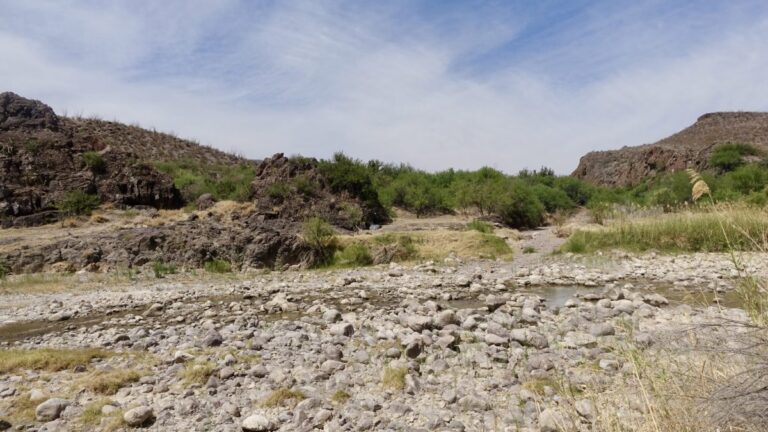On a hot, dusty day at the western border of Texas, the Rio Grande River that separates the state from Mexico just barely flows over a bed of exposed rocks, the water level low enough to wade across.
“You just have to hop from rock to rock without getting your feet wet,” says Charlie Angel, a local river guide.
Angell owns Angell Expeditions, a company that specializes in river rafting. In his 16 years as a guide, this was only the second time he’d seen the Rio Grande dry up in the Big Bend region. While there wasn’t any water, the river had turned into a low, choppy path of puddles.
For centuries, the Rio Grande has supported ecosystems for humans and wildlife along the Texas-Mexico border. In some places the river is plentiful, in others it is not.
In western Texas, the Rio Grande has long served as a desert oasis, drawing visitors to the Big Bend for canoeing and rafting, but current water levels make it nearly impossible to navigate.
As opportunities for river adventures diminish, the tourism industry must adapt to a new reality: parts of the river may disappear entirely.
“It’s a terrible situation for business,” Angell said. “We’ve had clients who really want tours, but as the date approaches we tell them the section they want is not available because it’s just a dry riverbed.”
Where he was standing, he said, it would take 25 times as much water to float a boat.
Angel’s day trips to the Rio Grande are down 60 percent this year, and he believes the river is dying. “You can’t look at the river and say, ‘Oh, it’s going to get better,'” Angel said. “I don’t think it’s going to get better.”
David Dean, a hydrologist with the U.S. Geological Survey who has studied the Rio Grande in the Big Bend for the past 18 years, said the river’s water levels have never been predictable.
“There’s a saying that goes, ‘If you fall in the Rio Grande, just get up and dust yourself off,'” Dean said.
He said the rivers here have always lowed, highed and sometimes flooded due to different water sources and weather patterns, but the current low water levels have more to do with the way they’re managed.
“What you have to understand about the Rio Grande is that it’s a binational river, so it’s managed jointly by the U.S. and Mexico,” he said.
Most of the Big Bend’s Rio Grande water comes from Mexico, and while climate change is part of the problem, Mexico has been reducing the amount of water it releases across its border despite treaty obligations.
For Big Bend’s tourism industry, a completely dried-up river is a marketing problem.
“Tourism is, without question, the economic driver of West Texas,” said Brewster County Tourism Director Robert Alvarez.
Brewster County doesn’t have any big box stores or big corporations. The oil and gas industry is a few hundred miles north. Without those economic players, tourism is a big part of the economy, and it’s disappointing when tourists can’t get on the river.
So Alvarez and the tourism bureau changed course. Now they don’t actually promote the Rio Grande in the Big Bend. There are still some photos of the river in promotional materials, but you won’t see any boaters on the water.
“We’re going to change it to a place that showcases zip lining and hiking,” Alvarez said.
Local outfitters like Charlie Angell are also leaning into these alternatives. “I don’t think in my lifetime the Rio Grande will be good for rafting in this part of the country,” he says.
His company now offers hiking, bike tours, bird watching and other tours.
As the fight over water supplies to the Rio Grande continues, some Texas lawmakers are discussing cutting aid to Mexico, which could mean more water going into the river in the future. But for now, Angel is preparing for the time when his on-the-water adventures are no longer his job.
“Over time I’ll get older and grumpy and just go on road trips and wax poetic about what the river used to be like,” he said.
There’s a lot going on in the world, and Marketplace is here for you.
Marketplace helps you analyze world events and bring you fact-based, easy-to-understand information about how they affect you. We rely on your financial support to keep doing this.
Your donation today will help power the independent journalism you rely on: For as little as $5 a month, you can help sustain Marketplace and continue covering the stories that matter to you.

